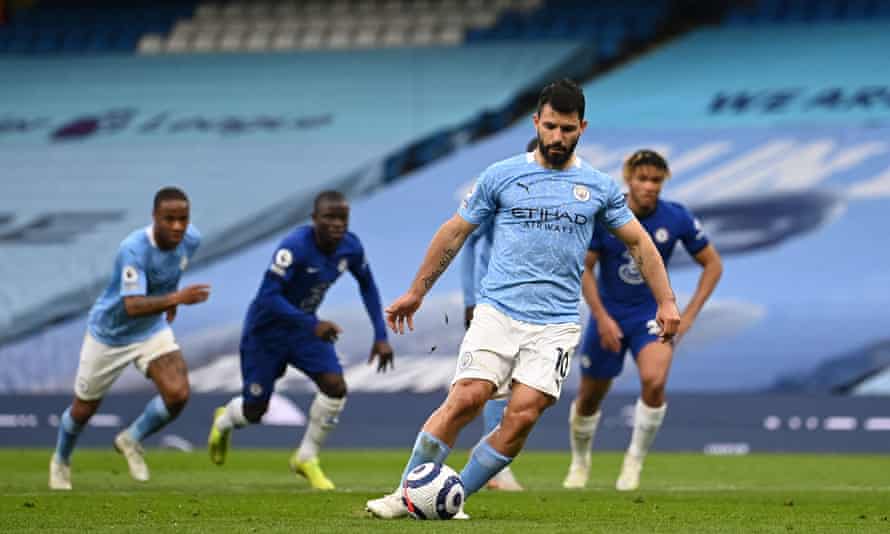It took two years for Antonín Panenka to perfect the flop-wedge penalty that bears his name. First he practised it against the Bohemians goalkeeper Zdenek Hruska in training shootouts, on which they would stake beer and chocolate, then in friendlies and league matches. And then, with Czechoslovakia 4-3 up on penalties in the 1976 European Championship final, he saw the West Germany keeper Sepp Maier move early – and scooped the ball impudently over him, not only securing the trophy but instantly trademarking a new move.
The secret, Panenka explained to Ben Lyttleton in his book, Twelve Yards, was to use a long runup to see what Maier was going to do. “I ran fast, because then it’s harder for the goalkeeper to read your body language,” he said. “Even when I’m a yard away from the ball, Maier is already moving to the left. If I wasn’t using the chip, I would have put it in the opposite direction.”
I thought of those words after Sergio Agüero’s slow‑motion Panenka-style penalty fell meekly into the hands of the Chelsea keeper Édouard Mendy on Saturday night. “He used to do this in training but never used to score, so I don’t know why he has tried it,” said Micah Richards, as social media tutted and frothed. Afterwards, as Agüero issued an apology, the debate became not just about the miss – but the dubious merits of the Panenka itself.
No one doubts it is a high-tariff move; one that leaves the taker either looking like a genius or a fool. But is it worth the risk? Well, that analysis requires a dive into a wormhole of science, art and the psychology of a good penalty kick.
The best place to start is with the LSE professor Ignacio Palacios-Huerta, an expert in discovering recurring patterns among kickers and keepers, in order to give teams a competitive advantage in penalties.
“It is not a terrible idea,” says Palacios-Huerta, whose clients have included Chelsea before the 2008 Champions League final and Holland ahead of the 2010 World Cup final. “In my dataset, the scoring rate of a true Panenka is statistically similar to that of any other type of penalty kicks; although it is slightly lower.”
How much lower, given around 80% of penalties are successful? Palacios-Huerta says the small number of Panenkas makes his estimates tentative. But he says “the scoring rate could be 4-5 percentage points lower than the average penalty kick”.

This analysis is backed up by a study of 1,716 penalty kicks in the big four European Leagues between 2015‑16 and 2018‑19, which looked at everything from the length of run-up to whether the ball was placed, powered or chipped, Panenka style. “The science certainly suggests the ‘placement’ followed by the ‘power’ strategies are much more likely to lead to a penalty being scored than the Panenka,” the lead author Dr Mikael Jamil says.
However, in his book Lyttleton points out there are also psychological effects of a well-timed Panenka. For instance during Euro 2012, Spain were level at 2-2 in the shootout with Portugal when Sergio Ramos scored with a Panenka to make it 3-2. Moments later Bruno Alves then stepped up and hit the crossbar. Three days earlier, with Italy 2-1 down after two kicks each against England, Andrea Pirlo dinked a penalty over Joe Hart. Again the momentum shifted. Ashley Young stepped up and hit the crossbar – and Italy went through.
There is something else critics of Agüero should also bear in mind.
Contrary to what many people think, going down the middle with a penalty is actually a smart strategy. Since the 2006-07 season Opta has tracked the location of every Premier League penalty, putting them into six equally sized zones, and found that shooting low left has a 77.2% success rate while going low right is 80% successful. That is what most players overwhelmingly do. However aiming a penalty kick centrally is 97.8% successful when the shot is high – and 80.2% if it is low.
In Twelve Yards, the former Chelsea keeper Petr Cech gives a compelling explanation why that might be: he says he never liked staying in the middle for a penalty because it might look like he wasn’t trying. That is backed by a scientific study that found keepers had “action bias” and tended to dive because they felt less blame would be attached if they failed to make a save.
Meanwhile, the question remains, why try a Panenka when statistically it has a lower chance of success? Palacios-Huerta believes the reason goes beyond scoring, and points out that Agüero maybe wanted to leave a mark in one of his final games for City. Panenka himself, meanwhile, saw it differently. “I saw myself as an entertainer and I saw this penalty as a reflection of my personality,” he said. “I wanted to give the fans something new to see, to create something that would get them talking.”
At least Agüero’s miss is unlikely to be costly. City will still win the Premier League and the striker’s reputation is secure. For Panenka the stakes were altogether higher. In fact after the game against West Germany, he was told that could have been punished if he missed, as it may have been seen as disrespecting the Communist system. What sort of punishment, Lyttleton asked him? “Thirty years working down the mines,” came the reply.
from Football | The Guardian https://ift.tt/3xX2pRf
via IFTTT

No Comment